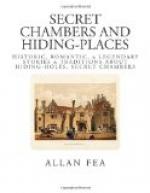Altogether, Harvington is far from cheerful, even to a pond hard by called “Gallows Pool”! The tragic legend associated with this is beyond the province of the present work, so we will bid adieu to this weird old hall, and turn our attention to another obscure house situated in the south-east corner of Berkshire.
The curious, many-gabled mansion Ufton Court both from its secluded situation and quaint internal construction, appears to have been peculiarly suitable for the secretion of persecuted priests. Here are ample means for concealment and escape into the surrounding woods; and so carefully have the ingenious bolts and locks of the various hiding-places been preserved, that one would almost imagine that there was still actual necessity for their use in these matter-of-fact days!
A remarkable place for concealment exists in one of the gables close to the ceiling. It is triangular in shape, and is opened by a spring-bolt that can be unlatched by pulling a string which runs through a tiny hole pierced in the framework of the door of the adjoining room. The door of the hiding-place swings upon a pivot, and externally is thickly covered with plaster, so as to resemble the rest of the wall, and is so solid that when sounded there is no hollow sound from the cavity behind, where, no doubt the crucifix and sacred vessels were secreted.
[Illustration: HIDING-PLACE, UFTON COURT]
[Illustration: HIDING PLACE, UFTON COURT]
Not far off, in an upper garret, is a hiding-place in the thickness of the wall, large enough to contain a man standing upright. Like the other, the door, or entrance, forms part of the plaster wall, intersected by thick oak beams, into which it exactly fits, disguising any appearance of an opening. Again, in one of the passages of this curious old mansion are further evidences of the hardships to which Romish priests were subjected—a trap in the floor, which can only be opened by pulling up what exteriorly appears to be the head of one of the nails of the flooring; by raising this a spring is released and a trap-door opened, revealing a large hole with a narrow ladder leading down into it. When this hiding-place was discovered in 1830, its contents were significant—viz. a crucifix and two ancient petronels. Apartments known as “the chapel” and “the priest’s vestry” are still pointed out. The walls throughout the house appear to be intersected with passages and masked spaces, and old residents claim to have worked their way by these means right through from the garrets to the basement, though now the several hiding-places do not communicate one with another. There are said to be no less than twelve places of concealment in various parts of the building. A shaft in the cellar is supposed to be one of the means of exit from “the dining-room,” and at the back of the house a subterranean passage may still be traced a considerable distance under the terrace.




